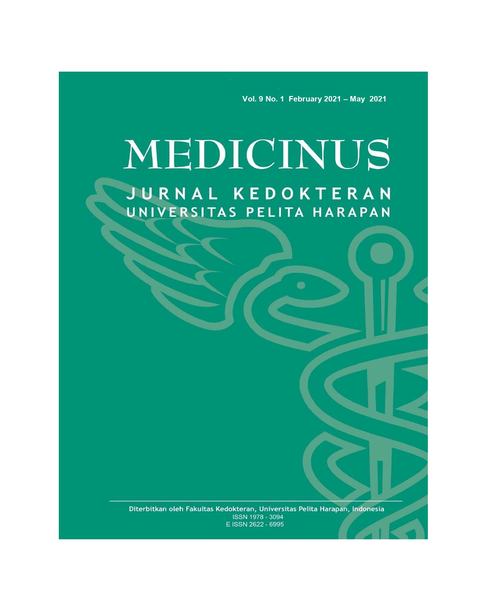Functional Endoscopic Orbital Decompression Surgery in Acute Rhinosinusitis with Orbital Complication : A Case Report
DOI:
https://doi.org/10.19166/med.v9i1.4197Keywords:
acute rhinosinusitis, orbital complicationsAbstract
Introduction: Orbital complications secondary to acute rhinosinusitis can cause permanent vision loss and death if not treated promptly and appropriately. The prevalence of orbital complications due to rhinosinusitis is more common in children than adults, occurring in 3-4% of children with acute rhinosinusitis. Lamina papyracea in children has many dehiscences, the nasal cavity tends to be narrower and the mucosa is softer than in adults, therefore causing the spread of infection more easily from the sinuses to the eyes. Clinical presentation: a 4-year-old child presented with eye swelling and pus discharge in the right eye for 5 days before being admitted to the hospital, for which she was treated with medication and did not improve. On physical examination, there is a narrow nasal cavity, inferior turbinate edema, and hyperemia, mucopurulent discharge. CT scan and MRI revealed contrast enhancement in intraorbital with suspected intraorbital abscess with orbital cellulitis, right pansinusitis, and buccal abscess. Functional endoscopic orbital decompression was done immediately.
Conclusion: Orbital complications due to acute rhinosinusitis are uncommon but potentially lead to more fatal complications. Early diagnosis and aggressive treatment of immediate functional endoscopic sinus surgery and antimicrobial therapy have a good outcome.
References
1. Singh SK, James E, Sabarigirish K, Swami H, Sood T. Bilateral orbital complications of pediatric rhinosinusitis. Med J Armed Forces India. 2014;70:68-72.
https://doi.org/10.1016/j.mjafi.2012.11.015
2. Torretta S, Guastella C, Marchisio P, Marom T, Bosis S, Ibba T, Drago L, Pignataro L. Sinonasal-Related Orbital Infections in Children: A Clinical and Therapeutic Overview. Journal of Clinical Medicine. 2019; 8(1):101. https://doi.org/10.3390/jcm8010101
3. Çelik M, Kaya KH, Yegin Y, Olgun B, Kayhan FT. Anatomical Factors in Children with Orbital Complications Due to Acute Rhinosinusitis. Iran J Otorhinolaryngol. 2019;31(106):289-295. https://www.ncbi.nlm.nih.gov/pmc/articles/PMC6764809/
4. Badr, D., Gaffin, J. and Phipatanakul. Pediatric Rhinosinusitis. 2017;4:268-281.
https://doi.org/10.1007/s40521-016-0096-y
5. Pradhan P, Samal DK, Preetam C, Parida PK. Intraorbital and intracranial complications of acute rhinosinusitis: A rare case report. Iran J Otorhinolaryngol. 2018;30:301-4. https://www.ncbi.nlm.nih.gov/pmc/articles/PMC6147267/
6. Surgery AA of O-H and N. Diagnostic Criteria for Rhinosinusitis. Clin Pract Guidel AAO. 2015;12.
7. Wan, Y., Shi, G. and Wang, H. Treatment of Orbital Complications Following Acute Rhinosinusitis in Children. 2016;33:401-6.
https://doi.org/10.5152/balkanmedj.2016.141065
8. Drago L, Pignataro L, Torretta S. Microbiological Aspects of Acute and Chronic Pediatric Rhinosinusitis. J Clin Med. 2019;8:149.
https://doi.org/10.3390/jcm8020149
9. Chang YS, Chen PL, Hung JH, Chen HY, Lai CC, Ou CY, et al. Orbital complications of paranasal sinusitis in Taiwan, 1988 through 2015: Acute ophthalmological manifestations, diagnosis, and management. PLoS One. 2017;12:1-14.
https://doi.org/10.1371/journal.pone.0184477
10. Chow AW, Benninger MS, Brook I, Brozek JL, Goldstein EJC, Hicks LA, et al. IDSA GUIDELINES IDSA Clinical Practice Guideline for Acute Bacterial Rhinosinusitis in Children and Adults. 2012;54:1041-5.
https://doi.org/10.1093/cid/cir1043
11. Wan, Y., Shi, G. and Wang, H. Treatment of Orbital Complications Following Acute Rhinosinusitis in Children. 2016;33:401-6.
https://doi.org/10.5152/balkanmedj.2016.141065
Downloads
Published
How to Cite
Issue
Section
License
Copyright (c) 2021 Michael Lekatompessy, Amanda P Kirana

This work is licensed under a Creative Commons Attribution-ShareAlike 4.0 International License.
Authors who publish with this journal agree to the following terms:
1) Authors retain copyright and grant the journal right of first publication with the work simultaneously licensed under a Creative Commons Attribution License (CC-BY-SA 4.0) that allows others to share the work with an acknowledgement of the work's authorship and initial publication in this journal.
2) Authors are able to enter into separate, additional contractual arrangements for the non-exclusive distribution of the journal's published version of the work (e.g., post it to an institutional repository or publish it in a book), with an acknowledgement of its initial publication in this journal.
3) Authors are permitted and encouraged to post their work online (e.g., in institutional repositories or on their website). The final published PDF should be used and bibliographic details that credit the publication in this journal should be included.





